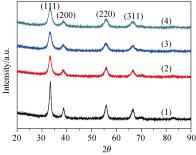1 Bielawa, H.; Hinrichsen, O.; Birkner, A.; Muhler, M. Angew. Chem. 2001, 40, 1061.  2 Zeng, H.-S.; Inazu, K.; Aika, K. Appl. Catal. A 2001, 219, 235. 2 Zeng, H.-S.; Inazu, K.; Aika, K. Appl. Catal. A 2001, 219, 235.  3 Li, Z.-L.; Liang, C.-H.; Feng, Z.-C.; Ying, P.-L.; Wang, D.-Z.; Li, C. J. Mol. Catal. A: Chem. 2004, 211, 103. 3 Li, Z.-L.; Liang, C.-H.; Feng, Z.-C.; Ying, P.-L.; Wang, D.-Z.; Li, C. J. Mol. Catal. A: Chem. 2004, 211, 103.  4 Aika, K.; Takano, T.; Murata, S. J. Catal. 1992, 136, 126. 4 Aika, K.; Takano, T.; Murata, S. J. Catal. 1992, 136, 126.  5 Luo, X.-J.; Wang, R.; Ni, J.; Lin, J.-X.; Lin, B.-Y.; Wei, K.-M. Catal. Lett. 2009, 133, 382. 5 Luo, X.-J.; Wang, R.; Ni, J.; Lin, J.-X.; Lin, B.-Y.; Wei, K.-M. Catal. Lett. 2009, 133, 382.  6 Saito, M.; Itoh, M.; Iwamoto, J.; Li, C.; Machida, K. Catal. Lett. 2006, 106, 107. 6 Saito, M.; Itoh, M.; Iwamoto, J.; Li, C.; Machida, K. Catal. Lett. 2006, 106, 107.  7 Wang, X.-Y.; Ni, J.; Lin, B.-Y.; Wang, R.; Lin, J.-X.; Wei, K.-M. Catal. Commun. 2010, 12, 251. 7 Wang, X.-Y.; Ni, J.; Lin, B.-Y.; Wang, R.; Lin, J.-X.; Wei, K.-M. Catal. Commun. 2010, 12, 251.  8 Yang, X.-L.; Zhang, W.-Q.; Xia, C.-G.; Xiong, X.-M.; Mu, X.-Y.; Hu, B. Catal. Commun. 2010, 11, 867. 8 Yang, X.-L.; Zhang, W.-Q.; Xia, C.-G.; Xiong, X.-M.; Mu, X.-Y.; Hu, B. Catal. Commun. 2010, 11, 867.  9 Yang, X.-L.; Zhang, W.-Q.; Xia, C.-G.; Xiong, X.-M.; Mu, X.-Y.; Hu, B. Chin. J. Catal. 2010, 31, 377.10 Fastrup, B. Catal. Lett. 1997, 48, 111. 9 Yang, X.-L.; Zhang, W.-Q.; Xia, C.-G.; Xiong, X.-M.; Mu, X.-Y.; Hu, B. Chin. J. Catal. 2010, 31, 377.10 Fastrup, B. Catal. Lett. 1997, 48, 111.  11 Zhao, L.-H.; Zheng, X.-M.; Fei, J.-H. Chin. J. Catal. 1996, 17, 227 (in Chinese). (赵雷洪, 郑小明, 费金华, 催化学报, 1996, 17, 227.)12 Niwa, Y.; Aika, K. Chem. Lett. 1996, 3. 11 Zhao, L.-H.; Zheng, X.-M.; Fei, J.-H. Chin. J. Catal. 1996, 17, 227 (in Chinese). (赵雷洪, 郑小明, 费金华, 催化学报, 1996, 17, 227.)12 Niwa, Y.; Aika, K. Chem. Lett. 1996, 3.  13 Luo, X.-J.; Wang, R.; Lin, J.-X.; Wei, K.-M. Chin. J. Catal. 2009, 30, 1125 (in Chinese). (罗小军, 王榕, 林建新, 魏可镁, 催化学报, 2009, 30, 1125.)14 Luo, X.-J.; Wang, R.; Ni, J.; Lin, J.-X.; Wei, K.-M. Acta Chim. Sinica 2009, 67, 2573 (in Chinese). (罗小军, 王榕, 倪军, 林建新, 魏可镁, 化学学报, 2009, 67, 2573.)15 Yu, Q.-Q.; Liu, Y.-L.; He, T.; Suo, Z.-H. J. Yantai Univ. (Nat. Sci. Eng. Ed.) 2010, 23, 23 (in Chinese). (于强强, 刘玉良, 何涛, 索掌怀, 烟台大学学报(自然科 学与工程版), 2010, 23, 23.)16 Guo, C.-X.; Wang, Y.-J.; Jin, W.-Y.; Luo, M.-F.; Lu, J.-Q. Chin. Rare Met. 2009, 33, 874 (in Chinese). (郭存霞, 王月娟, 金炜阳, 罗孟飞, 鲁继青, 稀有金属, 2009, 33, 874.)17 Ni, J.; Wang, R.; Lin, J.-X.; Wei, K.-M. Chin. J. Catal. 2009, 30, 185.18 Wang, X.-Y.; Wang, R.; Ni, J.; Lin, J.-X.; Wei, K.-M. Chin. J. Catal. 2010, 31, 1452 (in Chinese). (王秀云, 王榕, 倪军, 林建新, 魏可镁, 催化学报, 2010, 31, 1452.)19 Luo, X.-J.; Wang, R.; Ni, J.; Lin, J.-X.; Lin, B.-Y.; Xu, X.-M.; Wei, K.-M. Catal. Lett. 2009, 133, 382. 20 Singh, P.; Hegde, M. S. Chem. Mater. 2009, 21, 3337. 13 Luo, X.-J.; Wang, R.; Lin, J.-X.; Wei, K.-M. Chin. J. Catal. 2009, 30, 1125 (in Chinese). (罗小军, 王榕, 林建新, 魏可镁, 催化学报, 2009, 30, 1125.)14 Luo, X.-J.; Wang, R.; Ni, J.; Lin, J.-X.; Wei, K.-M. Acta Chim. Sinica 2009, 67, 2573 (in Chinese). (罗小军, 王榕, 倪军, 林建新, 魏可镁, 化学学报, 2009, 67, 2573.)15 Yu, Q.-Q.; Liu, Y.-L.; He, T.; Suo, Z.-H. J. Yantai Univ. (Nat. Sci. Eng. Ed.) 2010, 23, 23 (in Chinese). (于强强, 刘玉良, 何涛, 索掌怀, 烟台大学学报(自然科 学与工程版), 2010, 23, 23.)16 Guo, C.-X.; Wang, Y.-J.; Jin, W.-Y.; Luo, M.-F.; Lu, J.-Q. Chin. Rare Met. 2009, 33, 874 (in Chinese). (郭存霞, 王月娟, 金炜阳, 罗孟飞, 鲁继青, 稀有金属, 2009, 33, 874.)17 Ni, J.; Wang, R.; Lin, J.-X.; Wei, K.-M. Chin. J. Catal. 2009, 30, 185.18 Wang, X.-Y.; Wang, R.; Ni, J.; Lin, J.-X.; Wei, K.-M. Chin. J. Catal. 2010, 31, 1452 (in Chinese). (王秀云, 王榕, 倪军, 林建新, 魏可镁, 催化学报, 2010, 31, 1452.)19 Luo, X.-J.; Wang, R.; Ni, J.; Lin, J.-X.; Lin, B.-Y.; Xu, X.-M.; Wei, K.-M. Catal. Lett. 2009, 133, 382. 20 Singh, P.; Hegde, M. S. Chem. Mater. 2009, 21, 3337.  21 Bachiller-Baeza, B.; Guerrero-Ruíz, A.; Rodríguez-Ramos, I. J. Catal. 2005, 229, 439. 21 Bachiller-Baeza, B.; Guerrero-Ruíz, A.; Rodríguez-Ramos, I. J. Catal. 2005, 229, 439.  22 Izumi, Y.; Iwata, Y.; Aika, K. J. Phys. Chem. 1996, 100, 9421. 22 Izumi, Y.; Iwata, Y.; Aika, K. J. Phys. Chem. 1996, 100, 9421.  23 Liang, C.; Wei, Z.; Xin, Q.; Li, C. Appl. Catal. A: General 2001, 208, 193. 23 Liang, C.; Wei, Z.; Xin, Q.; Li, C. Appl. Catal. A: General 2001, 208, 193.  |
